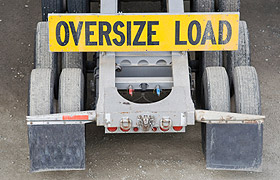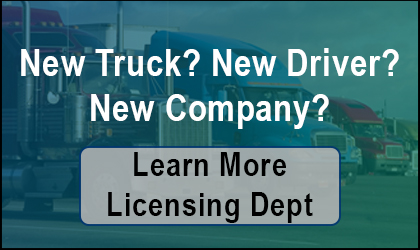
October 2015 Newsletter
posted in Alerts, Blog, Newsletter by Brian Gray
Glostone’s October 2015 Newsletter: ELD Compliance Questions, 2016 License and Permit Renewals Begin, Executive Approach to Compliance Management, and more.
ELD Compliance Questions
With final rulemaking set to be published by the end of this year, Electronic Logging Devices (ELD’s) will soon become the law of the land. With the right equipment and operational commitment, an ELD can be a very viable answer to the time, expense and frustration involved with being in compliance with Hours of Service Regulations. Without the right equipment and operational commitment, you can be placing your company at serious risk. You need to do your homework before you invest in an ELD system. Before you invest, make sure you have answers to a few key questions.
Your first question is to ask your vendor “Does the unit meet the new FMCSA requirements for an ELD?” As of this writing, the details within the final rule are not known. If the answer is “Yes,” you may have a problem. A “yes” answer to your question may mean your vendor really doesn’t understand, from a compliance standpoint, what he’s selling. The correct answer to your question should be “The unit meets today’s requirements and as soon as the new requirements come out, any modifications necessary will be made to stay in compliance.”
The data reporting for an ELD will be very different than the reporting and record keeping required for the International Fuel Tax Agreement (IFTA) and International Registration Plan (IRP). The reporting requirements for a compliant ELD will be all about the Driver. Reporting for IFTA and IRP is all about the Truck. If you intend to use your ELD hardware and data for IFTA tax reporting, many more important questions must be asked. The correct answer can depend on the type of operation you run.
The data needed to report IFTA taxes is simply the total distance in each jurisdiction of your fleet and the total fuel purchased in each jurisdiction by your fleet within a 3 month time period. Most ELD’s may be able to supply the distance information of each truck for the tax computation but there are some that fail when it comes to being able to supply the supporting data required for IFTA compliance. Carrier’s buying systems with the intent of using the data for IFTA should be asking questions such as:
- Can detailed trip reports be run by a starting and ending date for each unit?
- Will the report identify the origin and destination?
- Will the report identify the routes of travel?
- Can the beginning and ending odometer for each unit be produced for this time period?
- Will the report calculate total trip distance along with distance within each jurisdiction?
- Will this data be available for the next 4 years in case of an audit?
Another important question is… Read the Full Article HERE.
2016 License and Permit Renewals Begin
Renewing registrations, licenses, tax accounts, and many specialty permits is an annual headache carrier’s dread. Most 2016 renewals start in October and must be completed prior to December 31, 2015, including:
- Truck Registrations which must include proof of Heavy Vehicle Use Tax payment
- IFTA Licenses
- UCR Filings
- Oregon Weight/Tax Identifier Account
- New Mexico Mileage Tax Account
- New York Heavy Use Tax (HUT) Permit (due by November 30)
- And many individual Federal and State specialty permits like:
- Over weight/dimension Permits
- HazMat Permits
The renewal season floods state agencies with added work. Many states have undergone budget cuts and have reduced the locations and/or staffing to process these renewals. In their effort to control the workflow and provide timely service, these agencies open up the renewal process several months prior to the deadline. Proactive carriers renewing early within the time frame will find the process much less frustrating than the procrastinators who wait until the last minute. The procrastinators are often faced with long lines and/or long wait times to receive their new credentials. Those without their new credentials by January 1, 2016, can face heavy fines.
The time to plan which states you will operate in during 2016 is now. Defining your operations will determine what accounts and permits to renew. Renewing early is the only way to guarantee you won’t experience any down time or fines due to expired credentials.
Avoid the long lines and waits altogether by having Glostone process your renewals. We are experts in the renewal process, use the latest technology and have daily agency appointments to get your renewals processed timely and without the headache. Don’t wait until the last minute! Call us today!
Compliance Practitioner’s BOOT CAMP with Skip Nash- October 8th
The best course of action any carrier can take during this period of growing enforcement is to take steps to ensure their present safety practices are effective. The Compliance Practitioner’s BOOT CAMP™ has been a proven resource for developing effective safety programs for 18 years.
Whether you are new to DOT safety compliance or a veteran, the Compliance Practitioner’s BOOT CAMP™ will prepare you for the job of maintaining your company in compliance and doing your part to keep our highways safe. Click here to register
Driver supervisors will learn:
The rules that apply to their specific operations. Whether you are an OTR, LTL, general contractor, or allied industry, you will learn how to
- Understand & apply the FMCSRs to your operations
- Train drivers and prevent fines associated with driver’s logs
- Prepare driver files that will pass the toughest DOT audit
- Decide which drug & alcohol tests are required after an accident
- How long a driver is disqualified for convictions in a personal vehicle
HR professionals will learn:
Where DOT rules supersede other rules for qualifying a driver. You’ll know how to
- Complete Safety Performance History Investigations
- Respond to applicants who demand their ‘rights’
- Reply to prospective employers when they inquire about one of your past employees
- Know when an independent contractor is your DOT ’employee’
- What to keep in the driver file and what to place in personnel files
- How long to retain documents and which ones can be purged
- Avoid common mistakes that put your company at risk during litigation
AS A BONUS learn firsthand from experienced private sector compliance specialists how to improve your CSA scores during roadside inspections, as well as how MAP-21 impacts your operations. Register Today !
The FMCSA’s Top Priorities For The Remainder Of 2015
With only three full months left in 2015, the FMCSA has made public a list of their top five priorities for the rest of the year in a letter outlined by Acting Administrator Scott Darling.
- Safety Fitness Determination:
FMCSA is in the final stages of publishing a Proposed Rule that would increase the use of inspection data in making Safety Fitness Determinations for motor carriers. This rule will focus on incorporating current on-road safety performance data (i.e., roadside inspection and crash data, as is used for CSA scores) and evaluating carriers based on their own performance.
- Inspection Modernization:
FMCSA launched a new version of its inspection software program. It features a new look and feel and enhanced capabilities. Law enforcement personnel are able to obtain direct access to out-of-service notices, making roadside inspections quicker and easier for law enforcement officers.
- Unified Registration System:
The FMCSA will use an electronic “smart form” to improve the accuracy and timeliness of their motor carrier database. URS will streamline manual processes and combine several forms that regulated entities are required to submit into one unified registration – i.e. the “smart form.”
“It is important that we get this right,” Darling noted. “As such, we will move forward with a new phased implementation that will ensure a successful launch.” A Federal Register Notice will be published in October that will provide details on the updated implementation timeline.
- Compliance, Safety, Accountability (CSA) Phase III:
The FMCSA will begin training Federal and State investigators on the new crash BASIC investigation that focuses on identifying trends in carrier crash behavior.
FMCSA also will be fine-tuning the SMS algorithm to better identify carriers for investigation so it can intervene more quickly with those found to be at greatest risk. A second Federal Register notice announcing the preview of the changes will be published in the coming months.
- Electronic Logging Devices:
The FMCSA will work toward completing a final rule on ELDs that will help to protect drivers from harassment and reduce traffic fatalities.
“Although we cannot discuss the provisions of a Final Rule before it is made public, I can say that the rule is designed to benefit everyone by improving hours of service (HOS) compliance, which we estimate will prevent about 20 fatalities and over 400 injuries each year; helping businesses cut paperwork and save money; protecting drivers from harassment; and making it easier for law enforcement and safety inspectors to review driver HOS records.”
An Executive Approach To Compliance Management
All organizations are challenged with a myriad of Environmental, Health and Safety (EH&S) regulations but few industries compare to the trucking industry when it comes to the amount of regulation and severity of non-compliance. A trucking company’s very survival can depend upon its ability to manage compliance. Trucking companies are looking for ways to be compliant, reduce the cost of compliance, improve safety and still surpass corporate goals.
What are the correct steps a trucking company should take to be compliant and still operate profitably? A look into how the Best in Class companies do it can shed some light.
In a study done by the Aberdeen Group in April of 2011, titled “Compliance Management in Environment, Health, and Safety”, they found some very distinct differences in the approach to compliance between Best In Class (top 20%) companies to those they deemed as Laggards (bottom 30%).
Best In Class similarities:
- Regulatory Citations vs. previous year = -12%
- Recordable Injury Frequency Rate = .03
- Repeat Accident Rate = 1%
- Performance vs Energy Goals = +9%
- Operating Profit vs Corporate Plan = +13%
Laggards similarities:
- Regulatory Citations vs. previous year = +2% change
- Recordable Injury Frequency Rate = 6
- Repeat Accident Rate = 10%
- Performance vs Energy Goals = -9%
- Operating Profit vs Corporate Plan = -12%
The Best in Class companies were good not just in one area, they were able to effectively manage compliance performance, safety, energy use, and profitability. They were able to create safer and more compliant companies and are also able to gain a competitive edge through higher operational efficiencies at a reduced cost.
3 Common Characteristics with Best in Class performance:
- About 50% more likely than Laggards to have business processes that are standardized, auditable and transparent across the entire organization.
- Over twice as likely as Laggards to automatically collect EH&S data from across the organization.
- More than three times likely as Laggards to use subscription software for managing regulatory content.
How a company can move its compliance performance from Laggard to Average or Average to Best In Class:
- Most importantly, build compliance into the business process. Move compliance from a “cost of doing business, check the box” attitude to an integrated part of managing the business by establishing policies that continuously improve compliance. Establishing standardized, auditable and transparent processes so everyone does it the same way and can be measured along the way.
- Streamline the reporting process to everyone involved with your organization. In other words, make compliance visible. Best In Class companies look to create/improve visibility throughout their operations by investing in compliance management, reporting, dashboards and analytics.
- Automate the collection of EH&S data. 59% of Best in Class companies had automated software systems to collect the data vs only 23% of Laggards. Having the data enables intelligent decision making, improves visibility and promotes accountability.
If you operate trucks, compliance with environmental, health, and safety regulations must become an attitude ingrained into the culture of your company. Technology use in regulatory enforcement is shining an ever brighter light on the Laggards and the penalty for those not improving will be severe. The one thing to remember is this: the cost of compliance increases in direct proportion to the length of time that compliance decisions are put off. Delay is a decision — for the wrong way.
Glostone Trucking Solutions can be a resource for your compliance management. We can help with creating policies, systems, software, collecting data, reporting, dashboards and analytics. Call us at 503-607-1088 for more information.






